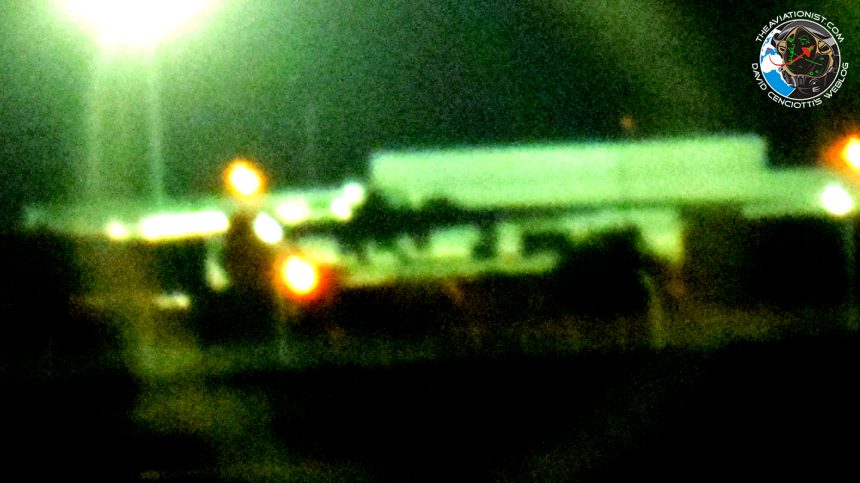The U.S. Air Force says it’s a “standard” B-2, but a pretty detailed analysis and some subtle details seem to suggest it might be something else.
The photographs you can find in this post were taken by three of our readers (Sammamishman, Zaphod58 and Fred) who have recently returned from a trip to monitor activities at Palmdale and Edwards Air Force Base, California.
These guys are not the average avgeeks. All the three either worked or are currently working around aircraft (one has worked on an Air Force Base ramp for many years and is well-respected as an aircraft guru, another works as an air medic and one is in the aerospace industry involved in advanced space and defense-related components) and they are extremely familiar with aircraft they observe and photograph with some high-end equipment. Sammamishman is the reader who sent us the video and photographs of the F-117s flying over Tonopah Test Range in 2016.
Among the things the trio photographed, there is also an unknown large flying wing type aircraft, hooked to a ground power unit, sitting on an apron located at Edwards South base between the hours of 10PM and 1AM on July 24-25, 2018.
The three spotters sent the images to the Air Force to determine if it is a classified article and subject to DoD censorship. After reviewing the images for a few days, the Air Force responded it was a B-2 Spirit.
“I however disagree with this story for several reasons that I will go into,” says “Sammamisham” in an email.
“Upon initial examination of the photos that night when we took them, it looked like a B-2 but under closer examination the proportions and fuselage configuration didn’t look right for a Spirit”.
The group has indeed produced an analytical analysis done on the shots that, provided it is correct, seems to indicate that the aircraft they observed that night at Edwards is not a B-2 Spirit.
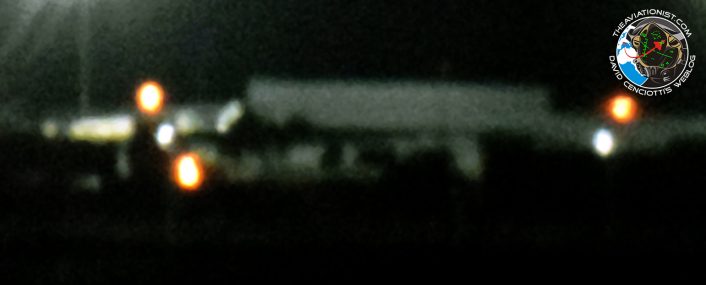
Here are the reasons why they believe it’s not a B-2.
– The spacing and size of what is assumed could be engine nacelles on either side of the center fuselage.
– Other bumps on the fuselage back that are odd or don’t seem to match the B-2.
– The larger pair of bay doors visible. The B-2 has multiple smaller bay doors for the bomb bay and engine access.
– The seemingly odd landing gear configuration.
– The slender wing section that curves oddly. The B-2’s wing should appear relatively thinker and straight at that view angle.
“Using the ground power unit, sitting next to it, as a measuring metric, (the AF uses Essex B809B-1 units with a 103″ length), we are able to estimate the height of the aircraft at 12.4′ and a wing span of around 130ish’. The B-2 is 17′ and 172′ respectively,” Sammamisham explains. “I also did a view angle comparison to the B-2 which also showed a difference in the wing tip flaps between this aircraft and the B-2. This aircraft was only out during the night hours. We returned the next morning to verify it was or wasn’t a B-2. The aircraft was no longer there (I have pics taken showing it gone). This, in my opinion, also lends credence to it not being a B-2 since it would be odd to pull a B-2 out to do ground tests during the night and early morning hours only.”
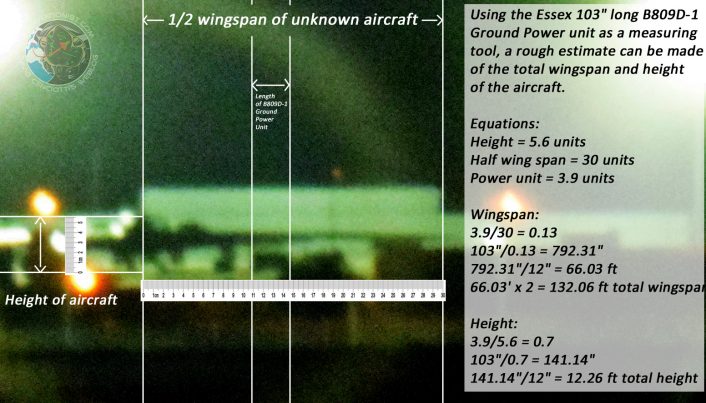
Let’s speculate. In fact, what at first glance seems to be a B-2 might really be something else considered we are basing our analysis on a cropped, blurry image taken at night from extreme distance (10 miles). Dimensions aside, there are some details that appear to be quite different from a standard Spirit stealth bomber: obviously we can’t rule out it’s a matter of perspective, objects in the line-of-sight, etc., but the differences in the spacing and dimensions of the engine nacelles (provided they are nacelles) are somehow evident.
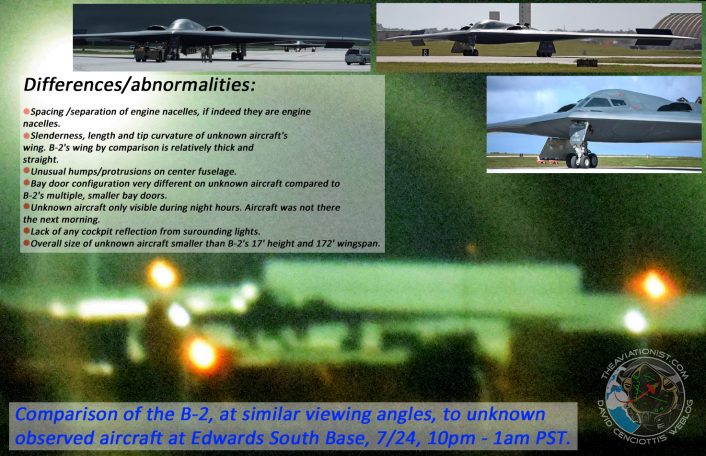
So, assuming the wing span is really 130ish and the aircraft is NOT a B-2 (as mentioned we are just speculating here), what is it?
We have a couple of options here but the one that seems more reasonable given its estimated dimensions, location and operating hours, is that the one depicted in the grainy shots is a secretive B-21 Raider bomber. The next generation long-range stealth bomber is known to be heading to Edwards AFB (so much so a B-21 Combined Test Force patch was already available on eBay months ago) for testing and the concept model of the B-21, has a lot of things in common with the B-2, including the position of the engine nacelles. Based on the B-21 Raider artwork released so far, the aircraft should be much similar to the B-2: the main difference is the “W” shaped trailing edge of the Raider that is an evolution from the Spirit’s sawtooth trailing edge.
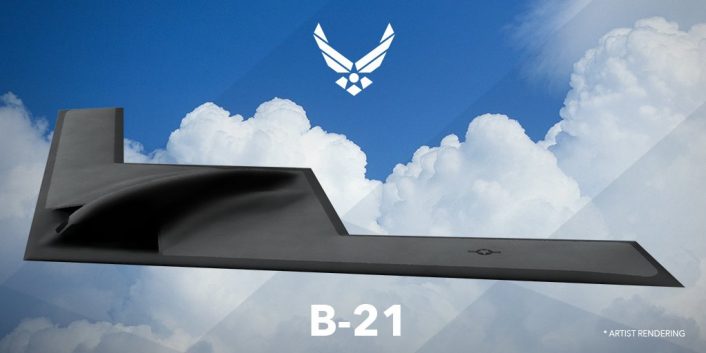
The B-2’s wingspan is 172 feet, the B-21 has a payload requirement said to be between two thirds and half that of the B-2. That’s why the Raider will probably be lighter featuring a wing span smaller than that of the Spirit.
If you combine all these things and assume the measurements are correct we might be looking at an early Northrop Grumman B-21 article.
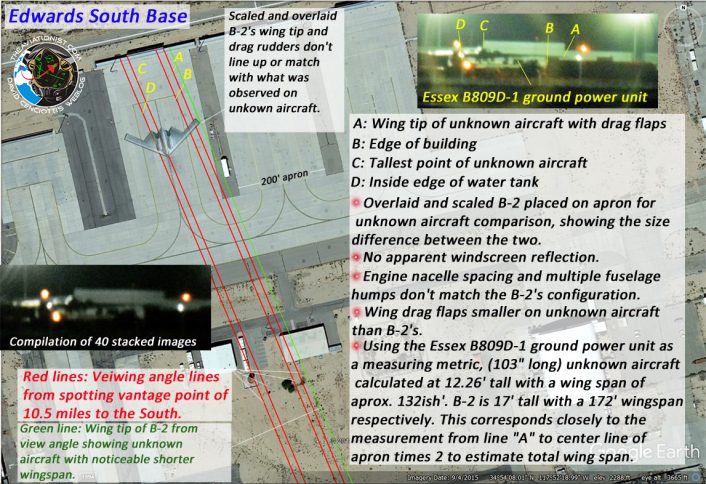
Our reader’s view spot was here: 34.761176, -117.800955
Less likely, it may also be a Northrop Grumman RQ-180.
In the Dec. 9, 2013 issue of Aviation Week & Space Technology, Senior Pentagon Editor Amy Butler and Senior International Defense Editor Bill Sweetman revealed the existence of the RQ-180, a secret unmanned aerial system (UAS), designed for intelligence, surveillance and reconnaissance (ISR) missions, and scheduled to be operational with the U.S. Air Force by 2015.
Developed by Northrop Grumman since 2008-2009, the stealthy RQ-180 is designed to operate in “contested” or “denied” airspace, as opposed to the non-stealthy RQ-4 Global Hawk that are intended for “permissive” scenarios.
In their analysis back then, Sweetman and Butler said: “It is similar in size and endurance to the Global Hawk, which weighs 32,250 lb. and can stay on station for 24 hr. 1,200 nm from its base. The much smaller RQ-170 is limited to 5-6 hr. of operation. […] The aircraft uses a version of Northrop’s stealthy “cranked-kite” design, as does the X-47B, with a highly swept centerbody and long, slender outer wings. Northrop Grumman engineers publicly claimed (before the launch of the classified program) that the cranked-kite is scalable and adaptable, in contrast to the B-2’s shape, which has an unbroken leading edge. The RQ-180’s centerbody length and volume can be greater relative to the vehicle’s size.”
Aviation Week worked with artist Ronnie Olsthoorn to construct concept images of the RQ-180 based on its attributes, including its “cranked kite” design, but these artworks seem to have little in common with what our readers spotted at Edwards.
Nevertheless, considered the quality of the photographs we can’t completely rule out the aircraft is the new stealthy drone that was given a couple of fuselage humps/nacelles similar to the B-2’s.
A pretty famous Northrop Grumman artwork shows an airframe adaptable for bomber and transport roles that was patented in 2012: it bears resemblance to both the B-2 and the X-47B’s shape. If that is the real shape of the RQ-180, then the one at Edwards may well be the new stealthy drone, 4 or 5 of those are believed to be operational somewhere in the U.S.

That said, let me say that the first time I saw the images I thought it was “just” a B-2 but further observations and Sammamisham’s account have made me a bit dubious. What do you think? It’s a B-2 or something else? Let us know using the comments section below or our Twitter, Instagram or Facebook pages.
Update Aug. 24, 15.30 GMT
Thanks to a Twitter follower (@Kiendl28) we have got a satellite image showing the aircraft on the apron at 18:05Z on Jul. 25. The resolution does not allow a clear identification but the fact the aircraft is parked in daylight seems to suggest there is nothing to hide and points towards the “standard” B-2.
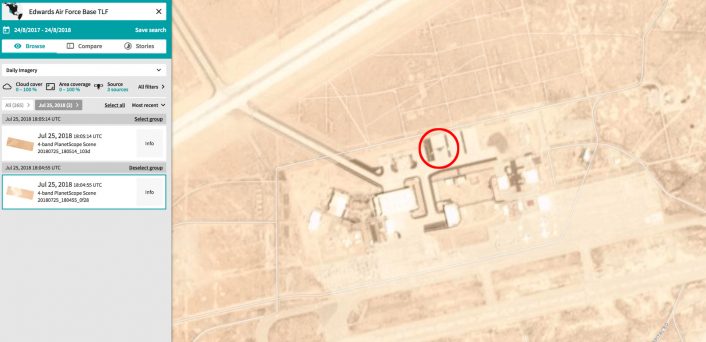
Image credit: Sammamishman, Zaphod58 and Fred for The Aviationist

